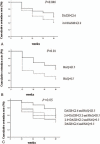High remission and low relapse with prolonged intensive DMARD therapy in rheumatoid arthritis (PRINT): A multicenter randomized clinical trial
- PMID: 27428186
- PMCID: PMC4956780
- DOI: 10.1097/MD.0000000000003968
High remission and low relapse with prolonged intensive DMARD therapy in rheumatoid arthritis (PRINT): A multicenter randomized clinical trial
Abstract
Objectives: To determine whether prolonged intensive disease-modifying antirheumatic drug (DMARD) treatment (PRINT) leads to high remission and low relapse rates in patients with severe rheumatoid arthritis (RA).
Methods: In this multicenter, randomized and parallel treatment trial, 346 patients with active RA (disease activity score (28 joints) [DAS28] (erythrocyte sedimentation rate [ESR]) > 5.1) were enrolled from 9 centers. In phase 1, patients received intensive treatment with methotrexate, leflunomide, and hydroxychloroquine, up to 36 weeks, until remission (DAS28 ≤ 2.6) or a low disease activity (2.6 < DAS28 ≤ 3.2) was achieved. In phase 2, patients achieving remission or low disease activity were followed up with randomization to 1 of 2 step-down protocols: leflunomide plus hydroxychloroquine combination or leflunomide monotherapy. The primary endpoints were good European League Against Rheumatism (EULAR) response (DAS28 (ESR) < 3.2 and a decrease of DAS28 by at least 1.2) during the intensive treatment and the disease state retention rate during step-down maintenance treatment. Predictors of a good EULAR response in the intensive treatment period and disease flare in the maintenance period were sought.
Results: A good EULAR response was achieved in 18.7%, 36.9%, and 54.1% of patients at 12, 24, and 36 weeks, respectively. By 36 weeks, 75.4% of patients achieved good and moderate EULAR responses. Compared with those achieving low disease activity and a high health assessment questionnaire (HAQ > 0.5), patients achieving remission (DAS28 ≤ 2.6) and low HAQ (≤ 0.5) had a significantly higher retention rate when tapering the DMARDs treatment (P = 0.046 and P = 0.01, respectively). There was no advantage on tapering to combination rather than monotherapy.
Conclusions: Remission was achieved in a proportion of patients with RA receiving prolonged intensive DMARD therapy. Low disease activity at the start of disease taper leads to less subsequent flares. Leflunomide is a good maintenance treatment as single treatment.
Conflict of interest statement
The authors have no conflicts of interest to disclose.
Figures



References
-
- O’Dell JR, Mikuls TR, Taylor TH, et al. Therapies for active rheumatoid arthritis after methotrexate failure. N Engl J Med 2013; 369:307–318. - PubMed
-
- Goekoop-Ruiterman YP, de Vries-Bouwstra JK, Allaart CF, et al. Clinical and radiographic outcomes of four different treatment strategies in patients with early rheumatoid arthritis (the BeSt study): a randomized, controlled trial. Arthritis Rheum 2005; 52:3381–3390. - PubMed
-
- Landewé RB, Boers M, Verhoeven AC, et al. COBRA combination therapy in patients with early rheumatoid arthritis: long-term structural benefits of a brief intervention. Arthritis Rheum 2002; 46:347–356. - PubMed
Publication types
MeSH terms
Substances
LinkOut - more resources
Full Text Sources
Other Literature Sources
Miscellaneous

